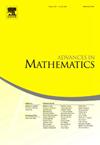耦合振子的代数度
IF 1.5
1区 数学
Q1 MATHEMATICS
引用次数: 0
摘要
近似耦合Duffing方程的周期解相当于求解一个多项式方程组。复数解的数量衡量了这个近似问题的代数复杂性。利用Khovanskii基理论,我们证明了这个数是由多面体的体积给出的。我们还展示了如何使用数值非线性代数计算所有解。本文章由计算机程序翻译,如有差异,请以英文原文为准。
The algebraic degree of coupled oscillators
Approximating periodic solutions to the coupled Duffing equations amounts to solving a system of polynomial equations. The number of complex solutions measures the algebraic complexity of this approximation problem. Using the theory of Khovanskii bases, we show that this number is given by the volume of a polytope. We also show how to compute all solutions using numerical nonlinear algebra.
求助全文
通过发布文献求助,成功后即可免费获取论文全文。
去求助
来源期刊

Advances in Mathematics
数学-数学
CiteScore
2.80
自引率
5.90%
发文量
497
审稿时长
7.5 months
期刊介绍:
Emphasizing contributions that represent significant advances in all areas of pure mathematics, Advances in Mathematics provides research mathematicians with an effective medium for communicating important recent developments in their areas of specialization to colleagues and to scientists in related disciplines.
 求助内容:
求助内容: 应助结果提醒方式:
应助结果提醒方式:


